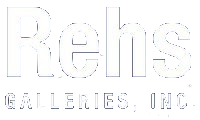COMMENTS ON THE ART MARKET

Antiques + Modernism
Preview Party:
November 7th from 6:30 – 9:30 PM
Show Dates:
November 8th – 10 AM – 6 PM
November 9th – 10 AM – 5 PM
November 10th – 11 AM – 4 PM
Location:
The Community House
620 Lincoln Ave.
Winnetka, IL
We have a limited number of complimentary
General Admission tickets still available.
If you would like to attend, please send us an email.
____________________
Greg Hildebrandt (1939 – 2024)
We learned that yesterday, October 31st, the great fantasy artist Greg Hildebrandt passed away at the age of 85. His wife Jean announced his death yesterday afternoon, describing him as “the sweetest man I ever knew”.

Greg Hildebrandt
Along with his twin brother Tim, who passed away in 2006, Hildebrandt was one of the most influential twentieth-century fantasy and science-fiction artists. Known collectively as the Brothers Hildebrandt, the twins originally aspired to work for Disney but made a name for themselves through their work for both DC and Marvel Comics. Their most iconic work was probably in 1977 when they designed the iconic poster for Star Wars. Before Peter Jackson brought J.R.R. Tolkien’s fantasy world to life through his film trilogy, the Brothers Hildebrandt’s Lord of the Rings illustrations, most notably their calendars, were some of the best-known artistic representations of Middle Earth and its characters. Later, in 1994, the brothers designed the third series of the Marvel Masterpieces trading cards, something that Julie Bell and David Palumbo, artists Rehs Contemporary has been working with for over a decade, would later do in 1996 and 2020, respectively. While the brothers collaborated extensively, they also worked as independent artists. Some of Greg’s best-known solo artworks were the cover art for Black Sabbath’s Mob Rules and the art and illustrations for several of IDW’s Star Trek comics. Greg continued to produce original art in his later years, with Rehs Contemporary having the opportunity to exhibit some of his work through the Art Renewal Center Select show in April 2024.
Paul Levitz, the president of DC Comics, paid tribute to Hildebrandt: “If Jack Kirby gave the world the visual dynamic of action, Greg Hildebrandt and his brother Tim gave it the rich decor of the imagination.” Greg Hildebrandt not only brought light and life into our own world but did the same to countless characters and stories that may have remained confined to the pages of books. He had a hand in shaping the image and trajectory of some of the most influential fantasy and science-fiction franchises today. He will be dearly missed.
____________________
Stocks & Crypto
I guess I preemptively bid adieu to the warm weather because we closed out October with a sunny 80° day here in NYC – I can’t explain it but I’m not complaining! Well, actually I probably could explain it… likely the same reason we saw flooding in the mountains of North Carolina this month. I’m sure everyone is aware of the devastation caused by Hurricane Helene, but perhaps some people don’t realize that Ashville, NC, is 2,000 feet above sea level and insurance regulators believed there was only roughly a 0.2% chance of the area experiencing flooding. This is not normal! Some of you might be wondering why I’m bringing this up… after all, we’re supposed to be talking stocks – but everything impacts the economy, and in turn, the stock market. Rough estimates by rating agency Moody’s and insurance broker Arthur J. Gallagher put recovery costs in the $34-35 billion ballpark. It’s worth remembering that these numbers are not simply dollar figures – it represents lost livelihoods, lost personal possessions, and most importantly, lost loved ones. I’ve grown up alongside the climate change movement, and while the narrative isn’t accepted by everyone, it is hard to deny that we are seeing stronger storms more frequently. While the cost of addressing the problem is significant, the long-term cost of carrying on as usual could be genuinely unmanageable. I guess only time will tell, but humans have this terrible habit of kicking the can down the road – we only seem to address problems that are plainly in front of our face. But it’ll be our children who face the consequences of our actions today.
While it is impossible to quantify the net effect of natural disasters on something like this month’s job report, the numbers were not good. Nonfarm payrolls increased by just 12k in October – well below market estimates and last month’s 220k figure. This is likely a temporary effect, but it’s notable nonetheless. Especially in the context of this being the first down month for the stock markets since April… then again, October is historically a loser in US Presidential election years. For the month, the Dow shed 1.1%, the NASDAQ gave up 0.3% and the S&P was down 0.9%... that said, it’s worth mentioning that all three indexes still set fresh all-time highs during the month. Nothing makes sense anymore.
Turning to currencies and commodities… both the Pound and Euro softened relative to the US dollar – down more than 3% and 2.5%, respectively. On that same note, gauges of expected volatility in currencies jumped earlier this week as investors brace for the upcoming US election, which could result in significant changes to economic policy. Gold futures continued testing the limits as it added another 4% to an already impressive 2024 run… it now sits in the mid $2,700 range. Crude saw some sizable fluctuations through October but ultimately ended with just a 1.2% gain. Over in the crypto arena everything was green. Bitcoin popped back over the $70k threshold, good for a roughly 14% gain on the month. Ethereum turned in a modest 2.5% gain, while Litecoin popped about 10%.
I guess we’ll have some more clarity on what the future holds in a week or so. Good luck to your team… I mean that with every bit of sarcasm you could imagine – somehow we all end up losers in this game.
____________________
Really!?
Teakwood Carving Gouges Estimate

Indian Teakwood
Model of the Windows
in Sidi Saiyyad's Mosque
at Ahmedabad by
Lockwood de Forest
and the Ahmedabad Wood
Carving Company
During the September 24th auction at Stair Galleries titled Design From 1860 to 1910, over 370 items were put up for sale. However, one item stole the show: an incredibly intricate teakwood carving by Lockwood de Forest, created in collaboration with the Ahmedabad Wood Carving Company. This impressive piece was a massive 6-foot-7½-inch tall, 10-foot-wide arched panel inspired by the famous sixteenth-century stone windows of the Sidi Saiyyed Mosque in the western Indian city of Ahmedabad.
The teakwood carving, which was part of the renowned collection of Ann & Gordon Getty, showcases De Forest’s admiration for Indian art. As an American painter and designer, De Forest gained recognition during the Gilded Age for integrating Indian craftsmanship into American home decor. In 1879, de Forest teamed up with design legends Louis Comfort Tiffany, Samuel Colman, and Candace Wheeler to form the design firm Associated Artists, where he took charge of architectural woodwork. Though the firm only lasted four short years, it left a lasting impression on 19th-century decorating trends. De Forest later partnered with Tiffany again to found an import business, establishing contacts in the western Indian region of Gujarat to ship fashionable Indian furniture and jewelry to the United States. They also set up a design company, through which De Forest created his own work by incorporating Eastern and Western styles into stunning designs. This carving exemplifies that fusion, displaying rich detail and artistry.
Even though the auction house initially anticipated a sale price of $10K to $15K, the item exceeded expectations. The piece's beauty and historical significance sparked a bidding war, ultimately fetching a staggering $175K (or $224K w/p), more than eleven times the initial high estimate. It was truly an impressive outcome!
A Rare Copy Of The U.S. Constitution Fetches Millions
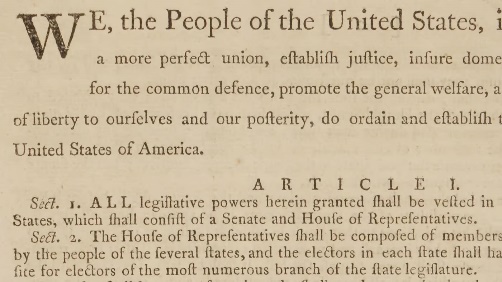
A paragraph of the
U.S. constitution from 1769
A rare 237-year-old copy of the U.S. Constitution sold at a North Carolina auction, becoming one of the most expensive historical documents to recently change hands. Printed in 1787, shortly after the Framers drafted the nation's governing blueprint, copies were sent to the governors of the thirteen states for ratification. The copy recently sold in North Carolina is believed to be the only one remaining in private ownership.
This rare Constitution is one of around a hundred copies originally printed by Charles Thomson, the secretary of the Continental Congress. Only eight are known to still exist, with the other seven housed in public collections. The document was accompanied by a letter from George Washington urging the states to ratify the new Constitution, stressing the need for compromise for the nation's long-term viability. Its history before 2022 remains largely unknown; it was rediscovered inside a dusty filing cabinet in Edenton, North Carolina, during the restoration of a house once owned by Samuel Johnston, the state's former governor. Its presence there is significant, as Johnston played a key role in guiding the state through the ratification process in 1789.
Bidding started at $1 million and lasted just over seven minutes, with bids coming in mostly over the phone. At $8.5 million, the bidding slowed to a pause. But after a few tense moments, a final phone bid of $9 million ($11.07 million w/p) clinched the deal. The last time a constitution like this went under the gavel was in 1891, and it sold for $400.
That evening, the Constitution wasn't the only high-profile item on the auction block. A first draft of the Articles of Confederation sold for $1 million ($1.23 million w/p), while a journal from North Carolina's 1788 Constitutional Convention fetched $85K ($104.5K w/p). The sale of these artifacts reflects a growing interest among collectors in securing pieces of America's early history, particularly as such documents become rarer and more valuable over time. As for the buyer, their identity remains undisclosed, shrouding the Constitution's next chapter in a bit of mystery.
On a side note, you may recall that I wrote about another early version of the Constitution (before Congress added the ratification resolution) bought by Ken Griffin at auction for $43 million in 2021. The following year, another copy known as the Adrian van Sinderen Constitution, was offered for sale with an estimate of $20-30 million (one of 500 copies printed in 1787 by John Dunlap and David Claypoole - only 13 are known to exist). Before the sale was to begin, the auction room canceled the sale, postponing it to "provide interested institutional parties with additional time to pursue fundraising efforts." Well, I would think enough time has gone by, and I haven't heard about a sale of the document... guess we will have to continue this waiting game to see how it gets written down in the history books.
____________________
The Dark Side
Van Gogh Experts Identify Fakes
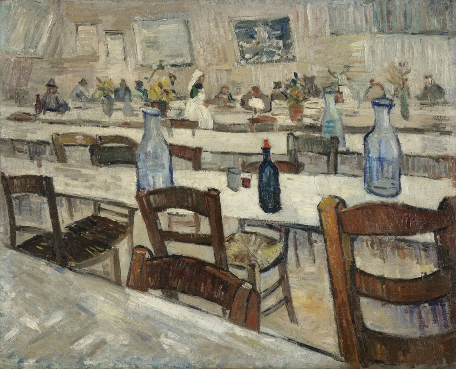
Interior of a Restaurant,
allegedly by Vincent van Gogh
but disputed by Van Gogh Museum specialists
Amsterdam’s Van Gogh Museum is breaking its normal policy by commenting on the authenticity of three alleged Van Gogh paintings currently held in private collections.
For many years, the Van Gogh Museum has refrained from determining which paintings are true Van Gogh works and which ones are fakes or forgeries. Instead, they focus on researching the artist’s life and educating the public about his work using the museum’s inventory. They seem to do an excellent job at this since the Van Gogh Museum is the most visited cultural institution in the Netherlands, attracting slightly more visitors than the Rijksmuseum. In breaking with museum policy, three specialists from the museum have recently discussed their findings regarding three works, which they regard as copies or forgeries of pre-existing Van Gogh paintings. Teio Meedendorp, Saskia van Oudheusden, and Louis van Tilborgh recently shared their conclusions with the British fine arts publication The Burlington Magazine.
The first painting, Interior of a Restaurant, was originally believed to be a second version of a verified Van Gogh painting by some specialists. Van Gogh created the original, Interior of the Grand Bouillon-Restaurant le Chalet, Paris, in 1887. The "second version" would not appear in any documentary evidence until the 1950s. The museum experts say that the brushstroke pattern and the color palette are inconsistent with Van Gogh’s work during his two years in Paris. Chemical tests on the painting also revealed traces of Manganese blue, a type of paint that would not become commercially available until 1935, forty-five years after the artist’s death. Furthermore, the flowers decorating the restaurant tables are different. The museum specialists show that the red flowers in the original are autumn begonias, in season in France in November and December. They speculate that the copy’s author was working from a black-and-white photograph and instead put sunflowers on the tables. Since sunflower season is in September, it does not make sense for Van Gogh to create the two paintings around the same time. This detail led Meedendorp, Van Oudheusden, and Van Tilborgh to determine that this was not simply a copy but a deliberate forgery. Sunflowers are closely linked with Van Gogh’s work, and the forger was likely trying to make the painting more appealing to try to pass the painting off as an original to sell.
The second painting is Head of a Woman, which the Van Gogh Museum previously authenticated as part of the estate of Gerbrand Visser. It was considered a product of Van Gogh’s time in Nuenen, where he created a series of peasant portraits. The painting later sold at Christie’s New York in 2011, where it made $993.3K w/p. Despite the museum’s seal of approval, things became complicated after a different version of the same painting came to light in a French collection. After examining the painting again, the museum now concludes that Head of a Woman is a copy created between 1902 and 1909 and that the French painting is Van Gogh’s original. They note, however, that the copyist was likely working from the original rather than a photograph. Finally, the third painting is a watercolor of a peasant collecting wood. It is based on a larger painting Wood Gatherers in the Snow, which Van Gogh created in 1884. The copy, meanwhile, was probably made around 1904 and solely shows one of the original’s several figures. The solo figure may not have caught the attention of some specialists since Van Gogh often created studies for later paintings using watercolor. Specialists theorize that the copyist may have been working from a photograph, as the colors are completely different, and several details are omitted. The leaves attached to the wood, a snow-covered farmhouse in the background, and the stick used to secure the wood bundle to the man’s back have all disappeared.
The three disputed paintings have previously been included in Jacob-Baart de la Faille’s 1970 Van Gogh catalogue raisonné. Due to their inclusion, this attribution has held for over fifty years. However, this may be a learning opportunity for some collectors and specialists, as attributions are never completely set in stone. They can change as new information comes to light, and no single academic’s word should be taken as gospel.
Auction Rooms: Will They All Do The Right Thing?
Over the years, I have written several articles about the need for more care in certain auction rooms regarding the authenticity of the paintings they sell. All of them use similar language in their terms and conditions; below are examples from three different auction rooms:
- While [Name deleted] representatives, to the best of their ability, describe the items for sale, any statement, whether oral or written, by the Auctioneer or by any [Name deleted] representative are mere opinions and shall not be deemed a warranty or representation regarding the property offered for sale.
- All items are sold as-is and where-is. [Name deleted] disclaims any express or implied warranties or guarantees as to the authenticity, condition, merchantability, fitness for a particular purpose, correctness of the catalog or supplemental material, or other description of the physical condition, size, quality, rarity, importance, medium, provenance, exhibitions, literature or historical relevance of any property. No statement made anywhere, by us, our employees, officers, or agents, whether written or verbal, shall be deemed such a warranty or assumption of liability.
- All properties are sold as is, and neither we nor the consignor make any warranties or representations with respect to any lot sold including but not limited to the correctness of the catalogue description, the physical condition, size, quality, rarity, attribution, authorship, importance, medium, provenance, exhibitions, literature or historical relevance of the property, and no statement anywhere, whether oral or written, shall be deemed such a warranty or representation.
Basically, they are not responsible for the authenticity of anything they sell – Caveat Emptor (Let the buyer beware).
Today, there are many online auction marketplaces which give auction rooms the ability to post their sales, enabling them to reach a wider audience. These sites also allow people to bid on the platform, and for that convenience, an additional fee is added to the auction house's buyer's premium. Potential buyers can search for a particular artist and these sites will compile a page with all the upcoming lots attributed to a particular artist. By doing so, they mix works offered at auction houses that do their due diligence alongside works offered by those that only sometimes verify the items they sell.
Of course, serious collectors understand that with reputable auction houses, there is a sense of security since their specialists often research the items offered and verify their authorship and provenance. But for those who may not understand that not all auction houses and galleries are the same, buyers looking for a nice oil painting will often fork over large sums of money for something that, with even the slightest bit of research, would be exposed as a fake.
As many of you know, we specialize in the work of Antoine Blanchard [born Marcel Masson (1910 – 1988)], the renowned painter known for his exquisite Parisian street scenes. Every week, we receive emails about upcoming auctions featuring paintings by Blanchard. Sadly, a high percentage of them are not authentic.
Recently, I decided to research one of these online auction platforms and looked for works by Antoine Blanchard. I filtered the results for those offered during the first nine months of 2024, leaving me with 107 works. After going through each of them, I found that of the 107 Blanchard works, only 39 were authentic, with the highest price achieved being $14,375 for a 13" x 18". Inauthentic works totaled 37, with the highest price being $10,000 for a 24" x 36". 10 paintings were merely attributed to Blanchard, 20 were prints, and one was sold as a Blanchard Jr. (still wondering who that is).
Removing the Attributed, Prints, and Jr. works leaves us with 76 paintings offered as being by Antoine Blanchard. This means over 48% of the listed paintings had questionable authenticity. It is truly ridiculous! The sad part is that these auction rooms could have contacted us for an opinion, which could have greatly reduced the number of 'fake' works offered and helped strengthen the market. To be clear, this is not a problem unique to Blanchard; this is the industry norm.
We began a research project focused on Antoine Blanchard's life and work in 2007. Our goal was and still is to help 'clean up' the market, and allow buyers and sellers to know whether or not they are looking at authentic paintings by the artist. Our research enabled us to create the Antoine Blanchard Catalogue Raisonné, and we are now regarded as the experts. It's worth mentioning that when we started the project, between 80 and 90% of the paintings up at auction had questionable authenticity. So, that 50% figure leads me to think we are making progress!
It is important to remember that I am only talking about Antoine Blanchard's paintings. Imagine how many other 'fake' works are regularly offered for sale at auction. Well, maybe you don't want to imagine that!
Now, the question is: should these organizations be required to perform their due diligence and uphold the standard of quality maintained by more reputable organizations? Though the art market is known for its lack of regulation, mostly for privacy reasons, should laws and industry regulations be enacted to ensure that companies that sell art, like auction houses and galleries, provide the information necessary for buyers to make an informed decision about their purchase?
In the meantime, until such laws are passed, buyers must keep the following in mind: if you are going to travel through the art world jungle, find the right guide before you become someone's next meal. When buying from established and reputable galleries, you have the comfort of knowing that they have done their research regarding a work's authenticity. You can also be confident that you are buying high-quality works in great condition, from the artist's best periods, and are truly ready to hang (have been cleaned, framed, etc.).
PS—Just before posting this article, I returned to the same online site and searched for upcoming works by Blanchard. Three came up: one listed as "After Antoine Blanchard," and the other two made me laugh.
Bouvier In Tax Trouble
While the so-called Bouvier Affair has, more or less, ended, the Swiss art dealer at the center of it all is again in trouble over an incredible amount of unpaid taxes.

Yves Bouvier
(photo courtesy of
Hpetit21/Creative Commons)
Yves Bouvier is a Swiss art dealer who gave his name to the decade-long legal drama between himself and the Russian billionaire Dmitri Rybolovlev. In 2017, Rybolovlev alleged that Bouvier worked as his agent in amassing an impressive art collection. Between 2003 and 2014, Bouvier acquired thirty-eight artworks for which Rybolovlev paid around $2 billion. The most well-known of these works was Da Vinci’s Salvator Mundi, which later sold at Christie’s for $450.3 million w/p, making it the most valuable painting in the world. Despite these substantial profits, Rybolovlev accused Bouvier of defrauding him of over $1 billion and, in some cases, that Sotheby’s helped him to do so. Sotheby’s has since been cleared in a lawsuit that concluded in February 2024. According to the numerous criminal complaints filed over nine years, Bouvier acted as Rybolovlev’s agent and was supposed to charge a 2% fee. However, Bouvier asserts that he was not acting as an agent but an independent dealer and, therefore, could determine his profit margins however he pleased.
While the string of legal actions between the two has concluded, Bouvier is still in trouble with his own government. Since 2020, there have been accusations of tax evasion thrown at Bouvier connected to the issue of his residency. Between 2009 and 2015, Bouvier claimed Singapore as his main place of residence. Therefore, the only tax he would have to pay in his native country is on the property and real estate he holds there. However, according to the courts, Bouvier continued to spend most of his time in Switzerland, conducted most of his business in Europe, and maintained most of his contacts and personal relationships with people on the continent. Therefore, claiming residency in a small Asian city-state seems absolutely ridiculous. In 2009, the alleged first year of living in Singapore, Bouvier only spent 23 days there, compared to 229 days in Geneva. According to investigators, this trend continued throughout the period in question, with Bouvier spending 17.5 days per year on average in Singapore and about 60 days per year in Geneva. According to the court’s recent decision, “Switzerland does indeed represent the center of his vital interests”. Because of this, Swiss courts are ordering Bouvier to pay his federal, regional, and municipal taxes accrued from these six years.
Additionally, Swiss authorities have frozen some of his accounts and confiscated some of the paintings he keeps at the Geneva Freeport. Bouvier has also surrendered some real estate and stocks he owns as collateral. But until his unpaid taxes are sorted out, the courts have ordered that he surrender some of his assets as a sequestration for the government to hold onto until the tax issue is resolved. The 3rd Court of Public Law ordered him to surrender 200 million Swiss francs (or about $230.9 million) until his federal taxes were paid. Meanwhile, the courts have not determined the amount owed to the city and canton of Geneva, but its administrative chamber claims that he owes approximately 712 million francs (or $822.3 million). Plus, a nice cherry on top of this sundae, the Swiss courts have ordered him to pay an extra 100K francs (or $115.5K) in legal fees due to his persistent appeals.
All this, the courts claim, is necessary to prevent Bouvier from transferring his assets outside of Switzerland. The government is only taking steps to prevent Bouvier from further evasion. It seems Geneva wishes to resolve this issue as quickly as possible since the federal sequestrations put in place may be the only thing keeping Bouvier’s other assets in Switzerland. Therefore, approving the city and canton’s own sequestrations, as recommended by the administrative chamber, is of great importance.
Dmitri Rybolovlev, on the other hand, just freed himself of some legal trouble. Switzerland’s attorney-general recently dropped charges against him that he had illegally acted to get Bouvier arrested in Monaco.
____________________
The Art Market
Bonhams London Old Masters
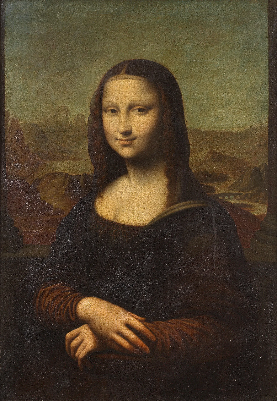
Mona Lisa
17th Century copy
On Tuesday, October 1st, Bonhams’ London location at New Bond Street hosted one of the first Old Master sales following a summer slouch in August. While the Old Master market has been progressively weakening in recent years, Tuesday’s sale showed that there was perhaps some pep in its step.
The auction opened with a bang, with the very first lot shooting right to the top. A seventeenth-century copy of da Vinci’s Mona Lisa was the first to cross the block and knocked it out of the park. Bonhams predicted it would sell for between £8K and £12K. But given the popularity the subject has enjoyed over the past century, it’s not too surprising that there would be several interested buyers. Bidding continued until the hammer came down at £80K / $106.3K (or £102K / $135.6K w/p), over six-and-a-half times the presale high estimate.
With that, the Mona Lisa copy more or less set the tone of the sale. The entire auction was held afloat by a group of paintings selling for exponentially greater prices than predicted. All three of the top lots had this in common. On top of that, all were portraits. The second place lot was a seventeenth-century portrait of a woman. It captures the embroidery of the subject’s dress in great detail, with a coat of arms in the upper right indicating her rank as a noblewoman. Specialists attribute the portrait to an artist in the “circle of”, or having been inspired by, the Baroque Italian painter Pierfrancesco Cittadini. The painting has been in the same family since it was bought at auction in 2003 for £7.4K. Due to the decline of the Old Masters market in recent years, Bonhams predicted the portrait would sell for a similar amount this time around. So it may have been a great surprise when bidding continued for longer than expected. The painting eventually sold for £40K / $53.2K (or £51.2K / $68.1K w/p), over five-and-a-half times the high estimate.
And finally, there was the third place slot, the biggest surprise of that day’s sale: a portrait of a young man attributed to Robert Home. The subject wears a classic bright red British uniform and is possibly a member of the artist’s family. Another portrait attributed to Robert Home sold earlier in the sale, assigned a £2K to £3K estimate range and selling for slightly under at £1.9K. The subject was also similar, a British officer in a red uniform. For whatever reason, though, buyers that day seemed drawn to this other painting to the point that the hammer price ended up far beyond the £5K high estimate. Bidders fought over the portrait until it sold for seven and a half times what was expected at £38K / $50.5K (or £48.6K / $64.7K w/p).
It was a surprising sale, to say the least. Of the two hundred twenty-one lots available at Bonhams that day, sixteen sold for more than double their presale high estimate. Only thirty-four lots sold within their estimates, giving Bonhams specialists a 15% accuracy rate. An additional fifty-three lots (24%) sold below estimate, while forty-two (19%) sold above. The remaining ninety-two lots (42%) went unsold. While the sell-through rate was somewhat of a failure, the handful of surprises helped generate an interesting result; the sale would not have reached the minimum estimate without them. But these sixteen lots, plus the twenty-six others that sold over estimate, brought the sale to within its presale estimate range of £537.2K - £812.8K, achieving £697K / $926.4K.
Christie's London Impressionist & Modern Works On Paper

Tête de
Mousquetaire by Pablo Picasso
On Tuesday, October 9th, Christie’s London hosted their Impressionist and Modern Art sale, focusing exclusively on works on paper. While these sales are not rare at the major auction houses, this particular auction seemed to be of great interest to many eager buyers, given the surprising results. The auction consisted of twentieth-century works by Chagall and Dali as well as older works on paper from earlier modernists like Matisse and Renoir. Ultimately, a Picasso took the top spot with Tête de Mousquetaire. Picasso created this pastel, chalk, and ink drawing a year before his death, inscribing a dedication on the back to his wife, Jacqueline. It’s a small drawing, measuring only 8 ¼ by-5 ¾ inches, yet Christie’s gave it an estimate range of £150K to £250K. Tête de Mousquetaire became one of the many works in the sale that sold for far above its expected range, more than doubling the high estimate figure and hammering at £540K / $706.2K (or £680.4K / $889.8K w/p).
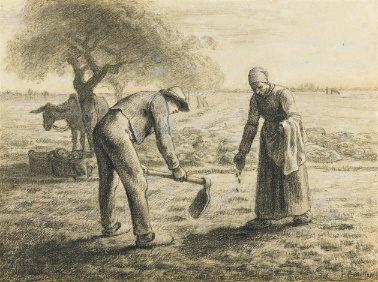
Les planteurs de pommes
de terre by Jean-François Millet
Les planteurs de pommes de terre is a preliminary sketch by Jean-François Millet for the artist’s 1861 painting of the same name. It shows the titular potato farmers planting seed potatoes for a later crop. It seems very typical of the artist’s work, combining Barbizon landscape painting with scenes of nineteenth-century French peasant life. It dates to around 1859 or 1860, mostly made from black chalk with bits done with crayon and pastel. However, Millet made other sketches and drawings of the same figures as early as 1851. This drawing last sold at Sotheby’s New York in 2016 for $334K w/p, and it seems Christie’s expected its value to have remained the same over the eight years. Specialists only expected it to sell for no more than £250K, yet several interested parties brought the final hammer price up to £350K / $457.7K (or £441K / $576.7K w/p). And finally, in the sale’s third-place spot, one of the more interesting works to cross the block that day was another Picasso. Hibou, Autoportrait is one of the artist’s most fascinating multimedia works. With the title literally meaning Owl, Self-Portrait, Picasso made an owl drawing with black pastel, cutting out almond-shaped spaces to insert images of the artist’s own eyes. For this, Picasso used David Douglas Duncan’s photograph Pablo Picasso’s Eyes, La Californie, Canne 1957, a copy of which also sold at Christie’s that day for £17.6K / $23.1 w/p (est. £4K to £6K). Picasso dedicates the drawing to Duncan in the bottom right-hand corner. As far as his drawings go, an estimated range of £150K to £250K is not bad. But given the multimedia composition and the incredibly unique and personal subject, it’s not surprising that the work ended up selling for over its high estimate at £340K / $444.6K (or £428.4K / $560.2K w/p).
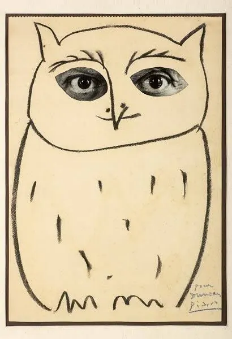
Hibou Autoportrait
by Pablo Picasso
Though not included in the top lots, one of the sale’s highlights was the number and variety of works by Marc Chagall. Twenty-three works, about a quarter of the total lots, were by Chagall, with eighteen selling above their high estimates. In fact, seventeen sold for more than double that number. The most valuable Chagall was the gouache and watercolor work Les amoureux au bouquet rouge, which sold for £352.8K / $461.4K w/p. But probably the biggest of Chagall’s surprises, the biggest of the sale, was a pair of ink drawings. Both are rather plain, with just India ink, no color, yet unmistakably in Chagall's style, especially the 1969 variation autour. Christie’s specialists are unsure if the drawing was for Chagall’s painting Songe du Clown or for Printemps. It makes more sense that it was a drawing for Songe du Clown since he finished the painting the same year, while Printemps was completed back in 1938. Chagall, however, could have simply returned to the theme later. Christie’s expected the drawing to sell for no more than £700, with the other for no more than £600. The variation autour ended up selling for £11K / $14.4K (or £13.9K / $18.1K w/p), while the other drawing, Au bord de la rivière, sold for £16K / $20.9K (or £20.2K / $26.4K w/p). Their hammer prices were, respectively, 15.7 and 26.7 times higher than their high estimates.
Fifty-three lots (58%) sold above their estimates, twenty-nine of which achieved more than double the high estimate. Six lots sold for more than five times the high estimate. Fifteen lots (16%) sold below estimate, while seven (8%) went unsold, giving the sale a strong 92% sell-through rate. Even though only sixteen of the ninety-one lots total (18%) sold within their estimates, the sale as a whole should have done phenomenally well. However, of the seven unsold lots, Christie's had given three particularly high estimate ranges. Henri Matisse's ink drawing Deux Odalisques (est. £100K to £150K), Franz Marc's gouache, tempera, and charcoal drawing Rotes Rind (est. £120K to £180K), and George Grosz's watercolor Orgie (est. £350K to £550K) all failed to find buyers that day. So it seems that the lots that sold over their estimates merely compensated for the small number of lots bought in. Christie’s predicted the entire auction to bring anywhere between £3.7 million and £5.7 million. Factoring in the bought-in lots plus the number of lots that sold over their estimates brought the final to just north of £5 million / $6.5 million.
Christie's London Modern British & Irish Sale
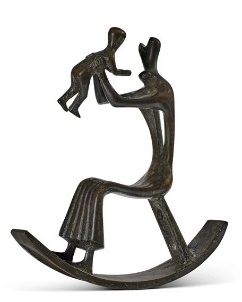
Rocking Chair No. 3
by Henry Moore
On Wednesday, October 16th, Christie’s London hosted this year’s second set of sales focused on Modern British and Irish art. The first round in late March did relatively well, but the autumn sales did slightly better in several regards. The evening sale was short, with approximately thirty lots in total, including some familiar names grabbing the top spots. Christie’s specialists predicted Henry Moore’s bronze sculpture Rocking Chair No. 3 would become one of the top lots, assigning it a £700K to £1 million estimate range. It was one of only seven lots expected to make at least £500K that day. However, not only did Rocking Chair No. 3 exceed its high estimate, it achieved more than double that figure. Several bidders fought over the bronze until the hammer came down at £2.35 million / $3.1 million (or £2.9 million / $3.7 million w/p).
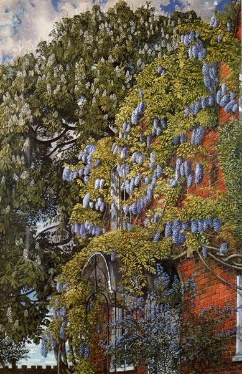
Wisteria at Englefield
by Sir Stanley Spencer
The Moore was the only surprise that day at Christie’s, with the other top lots remaining relatively close to their estimates. The second and third place lots both sold for £1.1 million / $1.4 million (or £1.4 million / $1.8 million w/p). Sir Stanley Spencer’s 1954 painting Wisteria at Englefield was commissioned by Gerard Shiel, who later helped found the Stanley Spencer Gallery in 1962, shortly after the artist’s death. The painting is set at Englefield, Shiel’s manor house in Berkshire, close to the village of Cookham, where Spencer grew up. Spencer created five paintings of scenes at Englefield, considered some of his career's most detailed landscapes. The painting last sold at Christie’s in 2015 for £962.5K w/p against a £800K high estimate. This time around, with a £800K to £1.2 million range, the Spencer sold within its estimate. The third-place lot was another bronze sculpture, Walking Woman by Lynn Chadwick. The bronze has been in the same private collection for nearly its entire existence, having been purchased by the seller in 1988 from Marlborough Gallery, which had received it directly from Chadwick. With Christie’s predicting it to sell for between £500K and £800K, Walking Woman sold slightly above estimate.
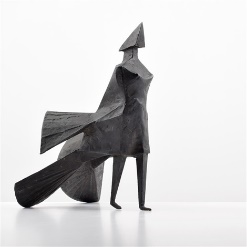
Walking Woman
by Lynn Chadwick
In some ways, the March Modern British & Irish auction outperformed the most recent October sale. The springtime sale consisted of thirty-two lots predicted to bring in a total hammer of at least £14.95 million. With 41% of lots selling within estimate, the March sale brought in £18.7 million. This time, Christie’s expected the thirty lots to bring in at least £9.9 million, with the auction eventually achieving £11.6 million / $15 million. So, the March auction did better regarding the total amount compared to the estimates. However, the October sale did better than the spring sale in other ways. With sixteen lots selling within estimate, the house specialists achieved a higher accuracy rate, landing at 53%. More lots during the March sale sold over their estimates (28% compared to October’s 13%), but the October sale had a better sell-through rate. Only seven lots (23%) went unsold compared to eight (25%) getting bought in during the spring auction. Despite another Lynn Chadwick sculpture (est. £700K to £1 million) going unsold, the October sale was still successful overall.
Christie's Paris Chagall Sale
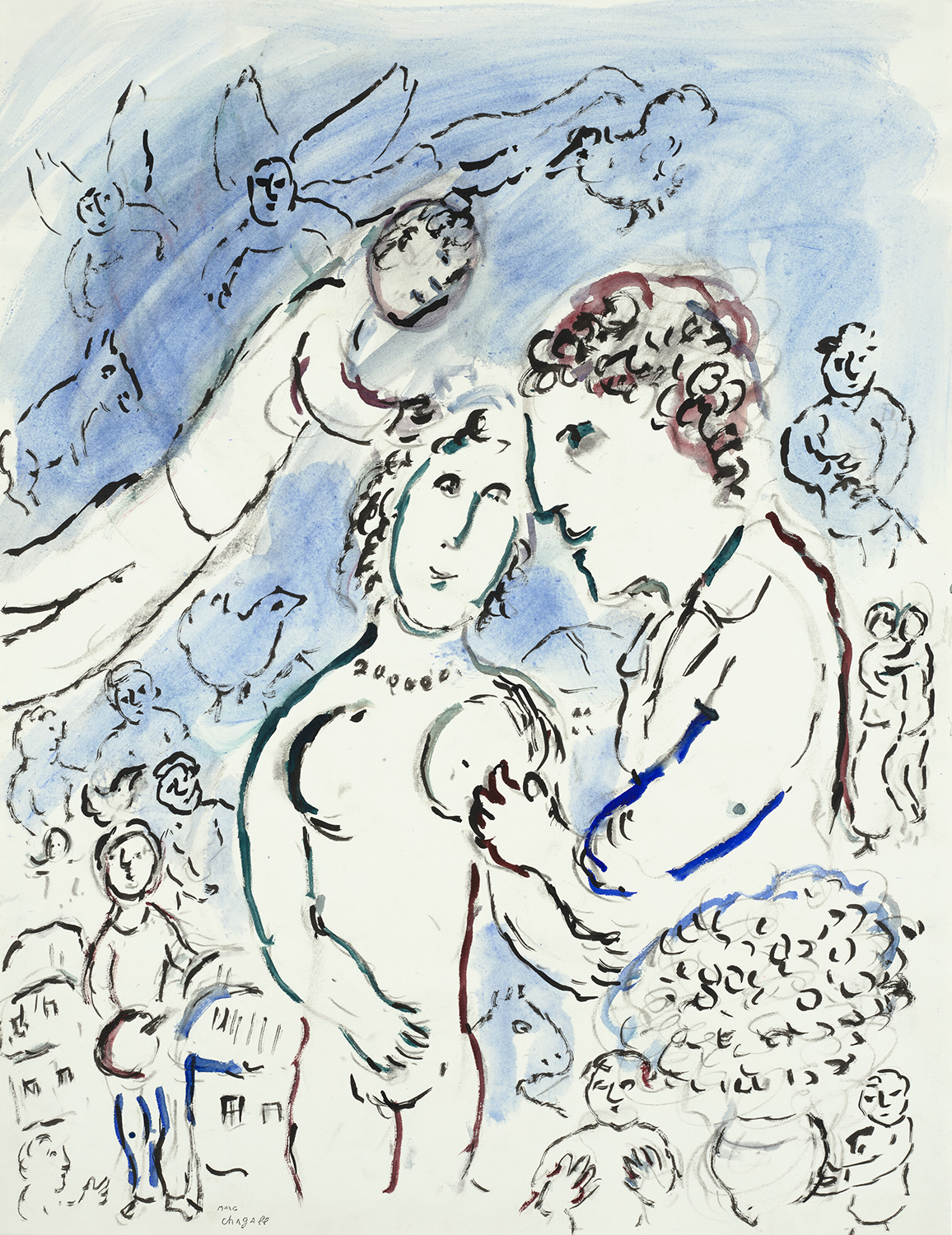
Autour de “Souvenance d'un printemps”
by Marc Chagall
For the past several years, Christie’s has put on a sale exclusively featuring the works of the Russian-born artist Marc Chagall. And every year, these sales consistently blow everyone’s expectations out of the water. And this past Tuesday was no different when Christie’s Paris hosted an auction featuring seventy-two works by the acclaimed artist with some incredible results.
Most of the works available at Christie’s were done on paper using media such as pastel, gouache, and ink. All came directly from Chagall’s estate through his heirs, making this the first time they have become available on the market. Things started with a bang with the very first lot, Autour de “Souvenance d’un printemps”, a 1983 work on paper made from tempera, gouache, and ink. It is a preliminary work executed in preparation for his later lithograph Souvenance d’un printemps. Christie’s specialists had predicted the work to become one of the sale’s top lots with a high estimate of €55K; it ended up setting the tone for the sale when the timer ran out, and it sold for €95K / $102.8K (or €119.7K / $129.5K w/p). A little later on, Chagall’s 1979 gouache and pastel work L'Ange aux ailes rouges dans le ciel jaune de Saint Paul came up. Like the autour from earlier, Christie’s specialists had predicted this to be one of the stars of the sale, assigning it a €38K to €55K estimate range. The angel surpassed not only its estimate but the standard set by the autour from earlier, hammering at €110K / $119K (or €138.6K / $149.9K w/p), exactly double its high estimate. And finally, the top lot proved to be one of the biggest surprises that day. Sainte famille en rouge et bouc en vert is a work on paper Chagall created in 1950 from oil paint, India ink, and gouache. Measuring slightly over 23 by 18 inches, Christie’s estimated it to sell for no more than €28K. It ended up soaring past these expectations, selling for more than four-and-a-half times its high estimate at €130K / $140.6K (or €163.8K / $177.2K w/p).
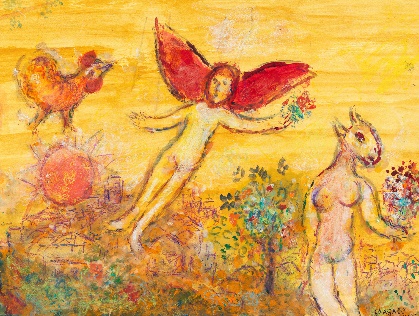
L'Ange aux ailes rouges dans le ciel
jaune de Saint Paul by Marc Chagall
While the sale as a whole proved exceptional by any other standard, the results were perhaps not particularly surprising for those who have been paying attention to the Chagall sales Christie’s has been hosting for the past several years. The first time I watched and recorded one of these sales was in 2022 when Christie’s London achieved £7.78 million against a £6.5 million total high estimate, with 90% of lots selling over their pre-sale estimate ranges. The next year, at the Christie’s Paris Chagall et la musique sale, 98% of lots selling over estimate resulted in a total hammer of €4.26 million against a €2.29 million high estimate. This time, Christie’s had initially predicted the seventy-two lots to bring in no more than €1.05 million. But with a relatively "paltry" sixty-nine lots (96%) selling for more than their pre-sale estimates, the house brought in €2.33 million, more than twice what they had expected. The remaining lots included two that sold within their estimates (3%) and one that sold for slightly under (1%). Like the previous Chagall sales, Tuesday’s auction saw a 100% sell-through rate.
Even more exceptional is that forty-one lots (57%) sold for more than double their high estimates. This is a lower percentage than last year when thirty-four out of fifty lots (68%) sold for more than twice the maximum, but better than 2022 when that number was nine out of twenty (45%). On Tuesday, however, two lots sold for more than ten times their high estimates. L’Ange au-dessus de l’homme à la tête de Torah is a relatively small ink-and-pencil drawing created around 1955, featuring some of Chagall’s favorite motifs and symbols, including an angel, flame, and the Torah. Given its simplicity, lack of color, and small size (10 ⅝ by 8 ⅛ inches), Christie’s estimated the drawing would sell for between €1.1K and €1.4K. With several interested parties fighting over the work online, the final bid finally came in at €18K / $19.5K (or €22.7K / $24.5K w/p), 12.8 times the pre-sale high estimate. Even bigger, though, was the surprise brought on by an even simpler drawing. Élie sur son char de feu shows Chagall’s take on the prophet Elijah and the chariot of fire as related in the Second Book of Kings. A final hammer price of €9.5K / $10.3K (or €11.9K / $12.9K w/p) is nothing mindblowing unless the initial high estimate is only €700, bringing the drawing’s ‘surprise factor’ up to 13.5.
____________________
Deeper Thoughts
Heirs Demand Paintings Back From Mauritshuis
The heirs of an art historian who donated paintings to the Mauritshuis museum in The Hague are asking for their paintings back, claiming that the museum violated the agreement made upon accepting the collection.
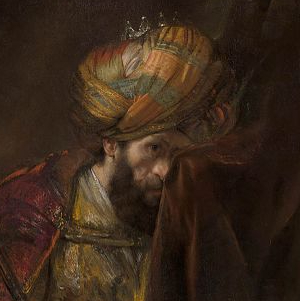
Saul & David
by Rembrandt (detail)
Abraham Bredius was a Dutch art historian specializing in seventeenth-century paintings. He served as director of the Mauritshuis for twenty years, between 1889 and 1909, helping to expand the collection and acquire Vermeer’s Girl with a Pearl Earring and Fabritius’s Goldfinch. Before his death in 1946, he donated twenty-five paintings from his collection to the museum, including works by Rembrandt and Jan Steen. The Bredius collection includes one of the museum’s greatest works, Rembrandt’s 1658 painting Saul & David. It also features Rembrandt’s Two African Men, one of the few depictions of free Black people in seventeenth-century Europe. The museum accepted them on the condition that they all be permanently displayed in the galleries. However, it has recently come to light that only five of the original twenty-five paintings, four by Rembrandt and one by Salomon van Ruysdael, are on view.
The case began when Bredius’s heirs, Otto and Sophia Kronig, visited the museum in 2021. They were surprised and disappointed to find very few of the works on display. After returning home and searching the museum website, they confirmed that most of the works were not being exhibited. The Kronigs are the grandnephew and grandniece of Joseph Kronig, a close friend of Abraham Bredius who some describe as his protégé. Since he had no children, Bredius left his entire estate to Kronig, leading some to speculate on whether Bredius and Kronig had a romantic relationship. According to the Kronigs and their lawyer, Bredius initially donated part of his collection to the Rijksmuseum. He later discovered that “the works were hung in a dark area near a staircase. He never wanted that to happen again.” Hence, his terms for donating paintings to the Mauritshuis were very clear-cut. However, after nearly eighty years, the museum seems to have neglected these conditions. “In reality, the museum accepted the collection but not the conditions”.
Since the museum breached the terms of accepting the collection, the Kronigs are asking that the paintings and other artworks be returned to them. They have emphasized, though, that their motives are not financial, as they do not plan on selling the collection. This is a matter of principle to them. The Kronigs have given the Mauritshuis a summons to appear before a judge. They have sent the same to the Dutch government since the Mauritshuis is a state-run museum.
While the Mauritshuis has refused to comment while the case is ongoing, its director Edwin Buijsen briefly tried to explain that three of the Bredius paintings previously attributed to Rembrandt have had their authorship questioned. While that provides some rationale for those three, it still needs to explain why the remaining seventeen paintings are kept away from public view. These paintings are not just the property of the heirs, but part of our broader cultural heritage, and their absence from public display is a loss to the viewing public.
Sculptures Mistaken For Trash
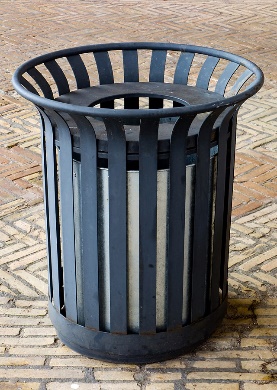
A Public Trash Bin
A Dutch museum employee threw away an art installation after thinking it was trash.
The French artist Alexandre Lavet exhibited a piece called All the good times we spent together at the LAM Museum, a food art museum in Lisse, halfway between Amsterdam and The Hague. The work is an acrylic sculpture handpainted to look like cans of Jupiler-brand beer. A statement from the museum reads that the sculptures symbolize “cherished memories shared with dear friends […]. ”. While evenings spent enjoying drinks may seem trivial in the grand scheme of things, they ultimately embody precious moments of connection.” Last week, a man filling in for the museum’s regular technician saw what looked like a pair of empty beer cans on the concrete floor against the wall. Thinking that some maintenance or construction workers had left them behind, he picked them up and threw them in the trash. The LAM makes an effort to exhibit works in unconventional ways, but it seems this location was a little too strange for the employee to recognize the works as art pieces.
The museum recognizes that this was all a simple mistake. The LAM’s director, Sietske van Zanten, said, “He was just doing his job in good faith. In a way, it’s a testament to the effectiveness of Alexandre Lavet’s art.” A museum curator discovered the sculptures in a trash bag. But rather than sweep this incident under the rug, the museum has appeared to embrace it. After salvaging the sculptures from the trash bag and cleaning them, the museum moved Lavet’s pieces to the museum entrance, where they are now prominently displayed on a plinth. Furthermore, their official commentary on the incident is on the front page of their website.
Of course, this is not the first time an art piece has been mistaken for trash and thrown away. For example, Damien Hirst exhibited an installation made from glass bottles, coffee cups, newspapers, and overflowing ashtrays, meant to represent the life of an artist. While this installation was shown at the Eyestorm Gallery in London, the gallery’s overnight cleaner mistakenly threw it away. Later on, Gustav Metzger had some of his work displayed at the Tate Britain in 2004. His installation Recreation of First Public Demonstration of Auto-Destructive Art included a plastic bag full of trash, which a museum employee threw away. Though the original bag was too damaged to use again, Metzger threw another bag together.
The Met Museum’s Newest Wing
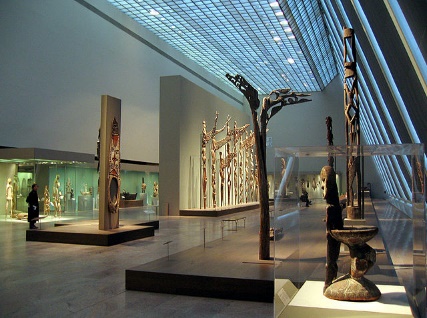
The Rockefeller Wing
prior to the renovations
(photo courtesy of Tomás Fano)
With the Metropolitan Museum of Art’s European Paintings collection getting a recent rehang, it’s time for another section of the museum to reveal its new look.
The Michael D. Rockefeller Wing of the Metropolitan Museum is dedicated to the art of “sub-Saharan Africa, the Pacific Islands, and North, Central, and South America”. While the Met has had ancient American art in its collection since its early years, the Department of the Arts of Africa, Oceania, and the Americas would not be established until 1969. In 1982, the Met officially dedicated the Rockefeller Wing. The museum closed the wing in late 2021 for renovations. Anyone who visited that part of the museum would probably agree that the Rockefeller Wing could have used some redesigning. The large room containing the painted ceiling from the Kwoma people of Papua New Guinea was very well-lit because of the large windows. However, the rest of the wing seemed like a dark movie theater, with bright lights illuminating the artifacts behind glass-lined walls.
WHY Architects are spearheading the current renovation efforts, working on what the Met called “a complete conceptual and physical overhaul”. The concept images of the new Rockefeller wing seem like a course correction of the ‘cloaked in darkness’ approach the old wing was going for. The designs for the new galleries seem bright and spacious, with visitors able to wander in a slalom-like fashion among the items on display. They also wanted to incorporate the galleries’ design into the collection, creating spaces with motifs that complement the displayed items. “Our buildings are works of art themselves, mediating the relationship between the environment, our collections, and the communities we host,” said the museum’s VP of capital projects, Jhaelen Hernandez-Eli. However, the Rockefeller Wing’s renovation also allows curators to reorganize their displays. They recognize that while Africa, the Pacific Islands, and indigenous America are grouped in a single department, it’s important to acknowledge the three areas as distinct. Having the chance to transform the entire wing from the ground up allows for a more modern curation, one that will “elucidate artworks’ aesthetic qualities, tether them to historical and cultural movements, highlight individual authors and the provenance of specific artifacts, introduce commentary by leading public intellectuals in diverse fields, and provide greater clarity and accessibility to visitors.”
Hopefully, the renovated wing will provide an alluring next step for Met visitors, leading them to continue on rather than turn back once they’ve hit the Greco-Roman sculpture garden. The Metropolitan Museum plans on opening the fully renovated and reorganized Rockefeller Wing on May 31, 2025.
Apollo Belvedere Back On Display

Apollo Belvedere
After five years of restoration, the famous Apollo Belvedere statue has been returned to public display at the Vatican Museums.
The Apollo Belvedere has been part of the Vatican Museums’ collection since 1511 by Pope Julius II and has since stood as one of the collection’s most iconic pieces. Since then, it has been influential in sculpture, figure drawing, and the genesis of neoclassicism in the eighteenth century. The sculpture is likely a second-century CE Roman marble copy of a fourth-century BCE Greek bronze statue showing Apollo as an archer. Countless artists, including Albrecht Dürer, Sir Joshua Reynolds, and Antonio Canova, have copied its pose and proportions for five centuries. Others, like Giorgio de Chirico, have included parts of the statue itself in their work.
The sculpture’s restoration began at the end of 2019 when museum specialists noticed certain weaknesses in its structural integrity. However, the project became delayed after Italy became one of the countries hardest hit by the pandemic. When specialists and technicians could finally access the sculpture, they made great progress after installing carbon fiber and steel supports into the Apollo’s base to relieve pressure on the statue’s legs. A similar solution had been put in place once before in the early nineteenth century by the neoclassical sculptor Antonio Canova. The team also had to replace the statue’s left hand, itself a sixteenth-century reconstruction. While cleaning the stone, the project specialists discovered a purple stain on the Apollo’s head. After analysis, they concluded that this was residue from a compound used to apply gold leaf to the statue’s hair.
This past Monday, October 14th, Cardinal Fernando Vérgez Alzaga helped unveil the newly restored statue in its normal spot in the Vatican Museums. Given the importance of the sculpture, the Vatican Museums funded the project through its wide network of supporters and donors organized in its Patrons of the Arts system, with the New York and Illinois branches contributing a great deal of money. Several outside organizations provided funding and technical aid in the Apollo Belvedere’s restoration, including the Italian state’s Museum & Cultural Heritage Directorate and the Bank of America Art Conservation Project. “It is therefore with renewed joy,” said Cardinal Vérgez Alzaga, “that this evening we return to the eyes of the world a shining Apollo, as radiant as Homer’s, a masterpiece of art and ingenuity that we hope will continue to defy time for centuries to come.”
Egypt's GEM Finally Ready To Open
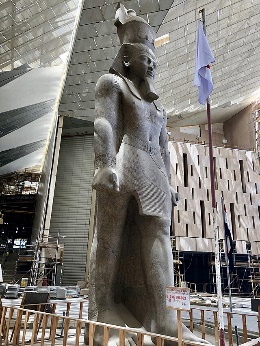
Colossus of Ramesses II
at the Grand Egyptian Museum
(while still under construction)
After over twelve years of construction and delays, the Grand Egyptian Museum will finally open to the public.
On Wednesday, October 16th, the Grand Egyptian Museum (GEM) opened twelve main galleries as part of a long-awaited partial opening. Civil unrest and the pandemic pushed the museum’s opening back several years, so the GEM’s opening may be one of the most highly-anticipated events in the world of antiquities. The GEM expected around 4,000 people to visit upon opening the select galleries, all of whom will be greeted by a 3,200-year-old colossus of the pharaoh Ramesses II in the main atrium. Most exciting for museum guests is the grand staircase, lined with ancient statues, which ascends to the rear of the building to reveal a view of the Great Pyramid. The new museum is so large and comprehensive in its presentation of Egyptian archaeology that Egyptologist Zahi Hawass estimates it would take a two-hour visit to see around 20% of its contents. When the GEM is fully opened, it will span half a million square meters, showcasing 100,000 items from across 700,000 years of human history. The most precious of the collection will be the entirety of Tutankhamun’s tomb, including the famous gold burial mask. Unfortunately, the Tutankhamun artifacts will not be part of the partial opening, as the collection remains in Cairo’s Egyptian Museum. Regardless, the GEM is set to become the largest archaeological museum in the world.
As far back as 1992, Egyptian authorities have been trying to build a major museum away from Cairo’s city center. They were concerned that the busy, densely populated environment might dissuade some tourists from visiting some cultural centers, namely the Egyptian Museum on Tahrir Square. The GEM is the centerpiece in a concerted effort to attract tourism to Egypt while simultaneously directing it away from Cairo. A new airport, Sphinx International, opened just last year, allowing easier access to Giza. Also, easyJet will soon offer flights between London Gatwick and Luxor twice a week. These efforts allow greater access to Giza and many other popular archaeological sites, such as the Valley of the Kings. Despite daily life in Egypt being relatively unaffected by the region’s current turmoil, foreign tourists may be hesitant to travel there, hence the ongoing efforts by the Egyptian government to bolster the country’s tourism sector.
The GEM’s deputy director, Al-Tayeb Abbas, stated that this is just a soft opening: “We are testing ourselves for the grand opening”. This trial run will allow museum administrators to remedy any issues they may face when operating at full capacity. Even with some parts still closed, the GEM can easily accommodate 15 million visitors every year, a figure that could potentially rival the Louvre, the British Museum, and the Met as one of the most-visited museums in the world. The full opening is scheduled for early 2025. With this potential, the GEM's opening is an event to look forward to, free from the problems the museum has previously faced.
Schiele At The Neue Galerie
On Thursday, October 17th, New York’s Neue Galerie unveiled its new exhibition, Egon Schiele: Living Landscapes. The Neue Galerie is a small museum in a converted Fifth Avenue mansion specializing in twentieth-century German and Austrian art. It is also known for its Central European-style café. When I visited on Sunday, it seemed like half of the people in the line outside the front door were exclusively there to have lunch. But the Neue Galerie is one of the best places to see the work of artists like Gustav Klimt, Ernst Ludwig Kirchner, and Egon Schiele. While predominantly known for his distinctive figure paintings, Schiele was primarily fascinated with life in general, making his landscapes a vital supplement to his more well-known work.
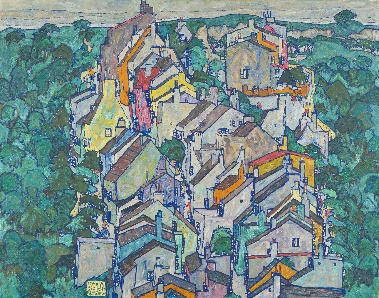
Town among Greenery
by Egon Schiele
The exhibition occupies four rooms and a corridor on the top floor of the museum’s building. It starts with Schiele’s childhood in the Austrian countryside. While he is often associated with the transition between the fin de siècle Viennese painters and the urban interwar Expressionists, he spent much of his life in towns like Klosterneuburg, in the rural areas to the northwest of the city. The curators highlight a pastoral yet somewhat turbulent childhood. Schiele would focus on decay and death in much of his work, expressed through his autumnal and winter landscapes. This was, in no small part, due to his father’s mental and physical deterioration from untreated syphilis, which included a suicide attempt when Schiele was 14 years old. He attended the Vienna Academy of Fine Arts starting in 1906, and much of his work between 1906 and 1909 consisted of oil paintings on board reminiscent of earlier paintings by Post-Impressionist masters. Still, he would not exhibit in Vienna until Gustav Klimt invited him to show four paintings at the Internationale Kunstschau. Despite his association with portraiture and other figure paintings, landscapes and other paintings of Austrian small-town life comprise the greatest bulk of Schiele’s total work. Apart from the occasional trip to the theater or a coffeehouse, he actively disliked Vienna and city life. He once wrote, “In Vienna there is only shadow, the city is black, everything is done by recipe.” He much preferred life in towns such as Krumau, Wachau, or Stein. His ‘townscapes,’ which started in 1911, are much different from his early landscapes. He broke away from the trappings of Post-Impressionism and brought the color palette and techniques of Symbolism and Expressionism, as seen in paintings like Town among Greenery.
However, the show is not completely devoid of Schiele’s more recognizable figure paintings. One of the galleries emphasized how Schiele became an innovator in portraiture by playing with concepts of subject and background by sometimes completely eliminating the background. This is most notable when the subject interacts with other elements in the scene, like in his Portrait of Karl Zakovšek, where the subject appears to be reclining in an armchair. However, the chair is absent, as is everything else in the background, so the subject is simply floating as if in a void. But there were also times when Schiele blended the subject and background into one, and the differentiation between figure and landscape painting blurred. This is best shown by his Current of Youth (Danaë) melding human and natural motifs. In an adjacent room, the curators show fragments of Schiele’s letters and his interests outside his art. His writings show that he made no differentiation between the different genres and that figure painting and landscape are just parts of the unity of all life.
Egon Schiele’s portraits, nudes, and figure paintings are his most distinctive works, yet his landscapes and townscapes are far more important when studying his work as an artist and an individual. Though small, the Neue Galerie exhibition was very comprehensive in looking at Schiele’s multifacetedness and his ability to transcend genre. It was very much worth the visit. Egon Schiele: Living Landscapes will be on view until January 13, 2025.
Whitney For Free Under 25
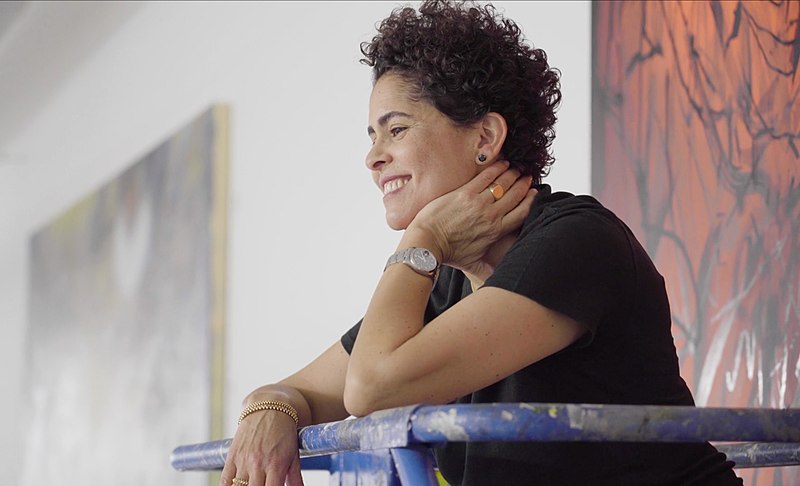
Julie Mehretu
(photo courtesy of Galerie Magazine)
Thanks to a generous donation, the Whitney Museum in New York will grant free admission to all visitors 25 years old and under starting in mid-December.
Julie Mehretu is one of the top painters living and working in the United States today. Born in Ethiopia and studying art in both the United States and Senegal, Mehretu creates what David Adjaye of Time described as “abstract three-dimensional landscapes that represent our often chaotic socio-political climate”. She maintains a studio in Manhattan’s Chelsea neighborhood, which makes it easy to also serve as a trustee of the nearby Whitney Museum. Museum admission prices have been climbing in recent years, and the Whitney is no exception. An adult ticket currently costs $30. Visitors aged 18 and under, however, can visit free of charge. And now, thanks to a large donation from several board members, $2 million of which came from Mehretu, the Whitney Museum will soon be expanding its free admission policy to all visitors aged 25 and under.
The Whitney already offers free admission to all visitors on Fridays between 5:00 and 10:00 pm, as well as all day on the second Sunday of every month. Demographic data the Whitney collected indicates that free admission is incredibly effective in attracting not only more visitors in general, but a younger, more diverse crowd. During the times free admission was in effect, half of all visitors were visiting the museum for the first time. Additionally, 80% of visitors aged 25 and under cite free admission as one of the main reasons for their visit. Scott Rothkopf, museum director, also commented that expanding the museum’s free admission policy will help achieve one of the administration’s goals “to go even further in making the Whitney one of the most accessible large museums in America”.
According to Rothkopf, this is an issue Mehretu has been pushing ever since he assumed his post in November 2023. Mehretu stated that the need for increased access to the arts for young people was the primary motivation behind her donation. “You can’t have any conversations around diversity, equity and inclusion without providing access, and the culture can’t change and it can’t continue to grow without new and diverse voices having access to the culture being created at the moment.” With arts funding being cut in Florida, Texas, and across the pond in Britain, young people’s ability to access cultural centers and the content they provide is more important now than ever. Many major New York museums like the Metropolitan Museum, the Museum of Modern Art, and the Guggenheim already offer some form of free admission or pay-what-you-wish. Hopefully, the Whitney’s expansion of their policy could lead to similar expansions at other American cultural institutions and greater access to the arts.
Satirical Statues Pop Up In DC
Washington, DC, has some very strange, very funny brand new public works of art, one of which “commemorates” the events of January 6, 2021.

The National Mall in Washington, DC
Pedestrians have noticed a new bronze statue near the walkways on DC’s National Mall, partway between the US Capitol building and the Washington Monument. It appears to have been cast in the shape of a desk with a large, cartoon-style piece of excrement resting on top of it. The nameplate on the desk bears the name of Congresswoman Nancy Pelosi. On the pedestal supporting the bronze, a plaque reads, “This memorial honors the brave men and women who broke into the United States Capitol on January 6, 2021 to loot, urinate and defecate throughout those hallowed halls in order to overturn an election.” The sculpture is specifically a reference to the ways that some members of Congress had their offices vandalized during the insurrection. During the events of January 6th, four people were killed, with rioters causing about $1.5 million in damages.
The artist is unknown, but the Park Service issued the permit to Civic Crafted LLC. On the permit, the organization describes the work and its meaning, with the desk itself representing “the heart of democracy, where decisions are made, voices are heard, and the future is shaped”. The emoji-style feces not only stand in for the actual acts committed during the riot at the Capitol but how those actions metaphorically tarnished the democratic process’s sanctity. While some have criticized the bronze, describing it as “tasteless” and an “embarrassment”, many others have offered their praise. One local passerby called it “brilliant satire,” while a social media user commented, “They nailed it!”
DC locals and tourists had a few days to view the desk statue before the Civic Crafted LLC struck again. On Monday, October 28th, the organization unveiled a new sculpture at Freedom Plaza, one block from the National Mall and a short walk from the White House. The second statue consists of a hand holding aloft a flaming tiki torch. The plaque below it names it the Donald J. Trump Enduring Flame. This is a parody of the idea of an eternal flame as a commemorative device, most famously used in the United States at the gravesite of President John F. Kennedy at Arlington National Cemetery. At the same time, the tiki torch references the Unite the Right rally in Charlottesville, Virginia, in August 2017. During this event, white nationalist demonstrators assembled in the college town and marched together carrying the ignited backyard accessories. Many have commented that this was an intimidation tactic and likely a conscious way to echo the torchlit parades of Germany during the Nazi era. Like the desk, it serves as a criticism of those who actively endanger democracy in the United States. One passerby noted that he approved of the tiki torch, commenting that it is “a perfect piece of satirical sculpture in its placement, in its timing, in its execution”. Of course, not everyone is expected to like the sculptures. But the arts are one of the most effective ways to express dissent. Talking about the desk, the National Mall’s chief of communications, Mike Litterst, commented that the statue is displayed appropriately since the National Mall is “a forum in which citizens can exercise their Constitutional rights of speech and assembly”.
The bronze desk will be displayed on the National Mall in Washington, DC, until October 30th, while the torch will be taken down the following day.
The Clark Institute’s Grand Gift
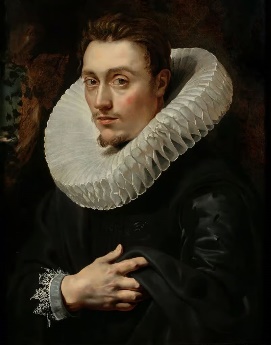
Portrait of a Young Man
by Peter Paul Rubens
The Clark Art Institute, a museum in a small western Massachusetts town, has recently received a priceless treasure trove of European art.
The Tavitian Foundation, established by the Bulgarian-born software executive Aso Tavitian, has made a historic donation to the Clark Art Institute. This generous gift includes 331 artworks and a $45 million fund for their care and preservation. The fund will also support the construction of a new Tavitian wing, designed by Annabelle Seldorff and set to be completed in 2028. The Tavitian donation, spanning from the Renaissance to the nineteenth century, features 132 paintings, 130 sculptures, 39 drawings, and 30 decorative pieces. Notable artists such as Vigée Le Brun, Parmigianino, Rubens, Van Eyck, and Watteau are represented, and the addition of statues by Bernini and Andrea della Robbia will make the museum’s sculpture collection far more robust.
The Clark has a fascinating origin story. Located in Williamstown, Massachusetts, it is one of the three most prominent cultural centers of the Berkshire Mountains in the western part of the state. Robert Sterling Clark, the heir to the Singer sewing machine fortune, amassed an impressive art collection with his wife Francine during the 1920s and 1930s. With the Second World War giving way to the Cold War in the late 1940s, the Clarks became worried about their collection’s safety. They, therefore, decided to look for a rural location to store their art, away from a large urban center that would be at risk of a Soviet nuclear strike, should one occur. It may seem like a rather strange and silly reason to build your museum three hours from both Boston and New York, yet nuclear annihilation is as good a reason as any to get museum visitors out of the city. The Clark Art Institute eventually opened to the public in 1955. Along with the Williams College Museum of Art and the Massachusetts Museum of Contemporary Art, the Clark is one of the cultural epicenters of western Massachusetts.
Before passing away in 2020, Aso Tavitian had a close relationship with the Clark Institute. He had served on its board of trustees between 2006 and 2012, frequently loaning works to the museum from his own collection for exhibitions. He also maintained close ties with the Metropolitan Museum of Art and the Frick Collection. The Tavitian Foundation plans to sell off the remaining nine hundred works in Tavitian’s collection through a series of sales held at Sotheby’s starting in February 2025. The substantial gift from his namesake foundation to the Clark aligns with his expressed wishes before his death. As a result, even greater crowds will hopefully flock to this quiet part of New England to appreciate what the museum administration calls a “most transformational gift”.
____________________
Oldies, But Goodies
How To Safely Navigate The Art Market: Authenticity
(Originally from 2001)
Over the next year, we will revisit some of the things we feel are important for people to consider when looking to buy a work of art - condition, size, authenticity, title, value, price, etc. (topics from many of my very first newsletters). We will call this feature: How To Safely Navigate The Art Market.
Our first topic (originally discussed back in 2001 and revised in 2008):
Authenticity
In this day and age, authenticity is a very important concern for everyone involved in the art market. One question we hear from time to time is, how do I know if the painting I am considering is real or by the artist in question? The plain truth is that unless you are considered a true expert in an artist's work or the period of art, you cannot be sure. The general art buyer needs to rely on the advice of a reputable art dealer or gallery... one who has a broad base of knowledge of the period, has done their due diligence on the specific work, will stand behind every work they sell, and guarantee its authenticity on their invoice.
I am sure your next question is - isn't a gallery's Certificate of Authenticity (COA) enough? Well, that all depends. If the gallery in question represents the artist (or their estate), then their COA is most likely valid and an important document you want for your records. However, a general COA for historical works is usually not enough, and they are often not even worth the paper they are printed on. I cannot tell you how many times people come to us with very official COAs (elaborate documents with signatures and all sorts of stamps and embossed seals) for a painting that is not authentic. Again, be sure that the gallery's invoice clearly states that they guarantee the work listed on the invoice to be by the artist they are selling. Make sure that the artist's name is clearly spelled out. For example - if you are buying an Antoine Blanchard or Julien Dupré, make sure the invoice states Antoine Blanchard (1910-1988) or Julien Dupré (1851-1910) and not something like A. Blanchard, J. Dupré or just Dupré - as there were other artists with the same last names.
Remember, just because a work has a signature on it does not mean it is by that artist. Over the years, we have encountered many works by Antoine Blanchard with Edouard Cortes's signature. I know - how can that be? During the early 1960s, Blanchard's style had a striking similarity to Cortes's work. In addition, Cortes' paintings were about twice as expensive. So, unscrupulous dealers would remove the Blanchard signature and add the Cortes name, allowing them to charge more. Back then, most people bought these works as souvenirs of their trip to Paris and gave little thought to any future value. Now, almost 60 years later, some people are not very happy to learn that their prized Cortes painting is actually an early Blanchard, which now does not even have a signature.
You should also find out if there is a recognized 'expert' for an artist (one that everyone in the art world looks to for an opinion) and make sure that the work you are considering has been seen and authenticated by that individual. Plenty of people in the art world claim to be an expert but claiming to be and truly being are two different things.
We see hundreds of 'fake' paintings hit the market each year, many of which end up selling. A majority move through the market in smaller auction rooms, but sometimes even the big boys get scammed. Even dealers who handle works out of their comfort zone end up getting taken. Some of these fakes were created to fool a buyer, others to satisfy the market's need (I will touch on this next), and then there are those done by artists who copied a painting to study an artist's style or technique. As a buyer, you want to ensure you are not one of the unlucky collectors who end up with a bad painting. This could, and most likely will, be a very costly mistake.
I brought up satisfying the market's needs. A great example of this is the work of Marcel Masson (Antoine Blanchard). Masson was a French artist who, in the late 1950s, began painting Paris street scenes and signing them Antoine Blanchard. It appears that his paintings became so popular that he could not keep up with the demand. Since demand outstripped supply, some dealers decided they could fill the void by hiring other artists to paint scenes of Paris and sign them Antoine Blanchard. We even know of one dealer who represented Marcel Masson and sold works by some of the other 'Antoine Blanchard' artists. Now, you might say this sounds very deceptive … and looking back, you are probably right. However, you need to remember that Marcel Masson did not own the name Antoine Blanchard (a pseudonym), so there was nothing to stop another artist from using the name. Also, nobody considered them an investment at that time -- people were not concerned with their future value. They just wanted a memory of their trip to Europe.
Another thing to keep in mind is if a deal seems too good to be true, there is probably something wrong. Works of art have a market value, and when someone offers you a painting by an artist for $10,000 and his work usually sells for $100,000 - watch out! I am not saying that you cannot find a bargain or hidden treasure, but 99 times out of 100, there is a reason why the painting is so cheap. Let's face it: if the painting is really worth so much more, why wouldn't the seller want the extra money?
Like we always say - do your homework. Check out the dealers considered experts by their peers and build a relationship with them. A good, trusting relationship will go a long way in protecting you, your money, and your heirs.
Below is a list of a few things that should raise a red flag (this goes for dealers and auction rooms):
The seller's invoice does not offer a guarantee.
The invoice does not state the full name along with the artist's birth and, when appropriate, death dates.
The seller knocks the idea that the opinion of the expert is needed.
The seller claims to be 'an expert' (sometimes this is true, but that is very easy to determine).
The seller presents you with their own 'certificate of authenticity' (sometimes these are fine; however, most of the time, they are not).
The seller is offering you work that is far below its market value.
How To Safely Navigate The Art Market: The Catalogue Raisonné
(from 2019)
Since I touched on expertise last month, I thought it would be appropriate to follow-up with an article about Catalogue Raisonnés (C.R.). I have used this term many times in my career, and occasionally, someone stops me asking what exactly a Catalogue Raisonné is. To begin with, the words are French and Wikipedia describes it as “a comprehensive, annotated listing of all the known artworks by an artist either in a particular medium or all media. The works are described in such a way that they may be reliably identified by third parties.”
Now that you know the technical definition, let’s tell you what it is all about. A catalogue raisonné is a book that is written by the artist’s leading expert/experts, with the aim of listing all of the works that the chosen artist has created. These projects usually contain photographs of the works, along with as much documentation as possible -- size, medium, provenance, signature location, date, inscriptions, labels that may appear on the reverse, exhibition history, and some go as far as including the work’s condition – something I personally think should only be noted if the painting has been drastically altered because of the restoration; otherwise this is far too subjective. I can tell you that while an expert might have a good handle on authenticity, some are far from experts on condition.
A Catalogue Raisonné will include an essay on the life and work of the artist as well as examples of their signatures, listings of museums and public collections where works can be found, and additional publications where the artist is mentioned. Much of this information needs to be gathered from old books, reviews, letters, diaries, account books, legal documents, dealer records, etc. – just finding all of this material takes an enormous amount of time. Even after much of the documentation is found, translated (if need be), and compiled, there are often large gaps left in the lives of many artists – some of which may never be filled in.
The end result is a publication (either printed or online) that will then be considered the ‘bible’ of that artist’s work. Future buyers, sellers, and researchers will have the ability to search the catalogue and see if a specific work is listed … if it is, then they are pretty confident it has been vetted and generally believed to be genuine – at least in the opinion of the individual, or committee, that conducted the research.
While the ultimate goal of these projects is to list every work the artist created, that is rarely possible as some works have been lost, destroyed, or will remain unaccounted for. Remember that not every current owner knows exactly what they have; some may never know about the project. Only when they decide to sell may they learn about the C.R.
One interesting result of a C.R. being published is that many more works begin to surface. This then sets the experts on a course to start a second volume (if it was done in book form). This new volume allows them to update or correct any information in the original volume. The nice thing about an online version is that corrections and additions can be made immediately – this way, the C.R. is always up-to-date. Remember, no matter how careful an expert is, mistakes will be made.
So, I am sure you want to know: how is a work accepted into a C.R.? Usually, the expert/experts have forms that need to be filled out, image requirements, fees (these normally range from $300-$2,000, but there are exceptions), and some require that every work is physically examined (this can be an expensive undertaking). If, after all the research is completed, an expert feels the work (in their opinion) is authentic, then they will usually supply the owner with a letter (or photo certificate) stating that they will include it in their research project. On the other hand, if they do not feel the piece is authentic, some will send you a letter stating that, and others will not. Today, there are many artists whose works cannot be sold without being authenticated by a specific individual or committee.
As I am sure you can surmise, these projects are challenging at best. Just trying to locate the works and then obtain reproduction-quality photographs is a time-consuming and, at times, an almost impossible task. Not everyone is willing to have their work properly photographed, and some do not want to take the time to do it. This is only one of the many hurdles that need to be overcome.
I know your next question – this is all well and good, but how long does it take to research and produce a catalogue raisonné? Usually, The time frame is about 15 - 20 years, but some projects dealing with more obscure artists can go on for 30 years or more. However, in the end, these publications are one of the best ways for individual buyers, collectors, and dealers to be sure that the work they are looking at is genuine.
Our gallery is currently researching the lives of Julien Dupré (1851 - 1910), Daniel Ridgway Knight (1839 - 1924), Emile Munier (1840 - 1895), and Antoine Blanchard (1910 - 1988) for their respective Catalogue Raisonnés. Both the Munier and Blanchard projects began online and will continue that way. Initially, the Dupré and Ridgway Knight projects were slated to be published in book form; however, we have now decided that these will also become online projects (update: the Dupré one is now live). This will allow everyone easy access to the information and give us the flexibility to continually update and change information as our research continues and new works appear.
How To Safely Navigate The Art Market - Expertise
(from 2018)
Many people in the art world use (and sometimes abuse) the word 'expert' - "Is he an expert?" "Who is the expert?" "Did you show it to the expert?" "I am an expert!"
The real question is - What, or who is an expert? To me, an expert is someone who has studied, in-depth, the area they specialize in, seen thousands of works by different artists from the period, and will acknowledge the fact that they are still learning. I am always happy to inform people that while I am considered an expert in 19th-century European paintings and, to even narrow that down a bit further, the world's expert on Daniel Ridgway Knight (1839-1924), Julien Dupre (1851-1910), and Emile Munier (1840-1895), I am always discovering new bits of information about each artist, and learning about 'new' 19th century artists.
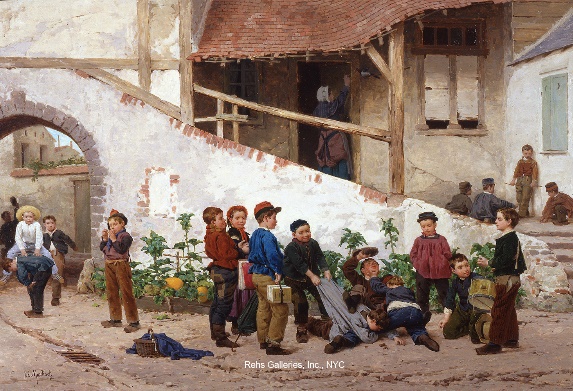
Recess
by Antoine Edouard Joseph Moulinet
I use the word 'new' because while 19th-century paintings are not 'new' and all of the artists have gone to the great beyond, there were so many of them that nobody will know them all, so sometimes an artist emerges that is 'new' to me. I know you are wondering why I don't know about all of them. Well, there were thousands upon thousands of artists working throughout the 19th and early 20th centuries. In addition, great quality works by many rarely appear on the market, so one does not take notice. A case in point - some years ago, we acquired a beautiful painting by the French Academic artist Antoine Edouard Joseph Moulinet (1833 - 1891). While Moulinet is/was a known artist of the period and exhibited at the Paris Salon, I never paid much attention to the few minor works that appeared on the market. It was not until this work was made available that I took notice. Then the fun began - scouring through our library to find biographical information, looking through our runs of Salon catalogs to see images of other works he exhibited, and reading the reviews of the Salon exhibits for any mention of the artist and his work. While I was able to gather some interesting information about Moulinet, I will be on the lookout for additional information for the balance of my career, not to mention other great quality works by him.
A true 'expert' can look at a work by a currently 'little known' (new) artist and determine whether or not it has merit - in their opinion, of course. They can determine, just by looking at the painting, its level of quality by referencing works they have seen by other well-known artists of the period, whether the subject matter is appropriate for the period, and if the artist was working during the height of the period or was someone who came years or decades later. In other words, for us, is the work something we would be proud to own, display, and, even more importantly, recommend? In the case of the Moulinet, the answers were yes.
Another often-asked question is -- How does one become an expert? The answer is easy - by looking and researching. Looking? Yes, viewing tens of thousands of works by the artists from the period and when it comes to specific artists, studying their work in depth. I do not want to imply that one needs to do extensive, independent, biographical research on the artists (unless you want to become the world expert), but one needs to look at their work, study their paintings, and have a basic understanding of the period in which they lived and worked. By looking, you will train your eyes to see the changes in an artist's style, subject matter, and quality throughout their career. It is also important to try to find the works the artist dated to determine when these changes occurred. You will also find that a real 'expert' will have the ability to give a pretty accurate date to undated works just by looking at them. Only then can someone start to consider themselves an expert, and when other people come to you for an opinion, then you made it!
While many of you will never become 'experts' in the area/areas you collect, you will be amazed to find that once you have seen hundreds of works by your favorite artist/artists, when a 'fake' appears, you will, at the very least, know that something looks a little odd. Remember, most of you will rely on someone's 'expertise' to guide and advise you … if you choose wisely, you will be well rewarded!
How To Safely Navigate The Art Market: Those Bare Spots
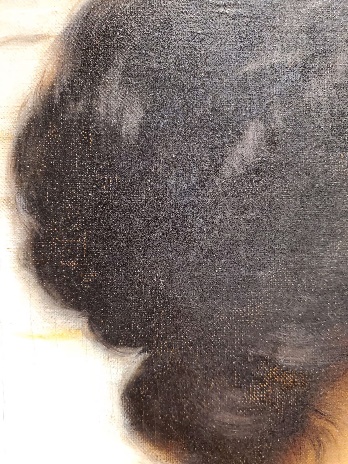
Skinned area in the hair
This month I am going to touch on something I consider a pretty serious condition issue -- those bare spots on the canvas, or what is commonly referred to as 'skinning', 'over cleaning', or 'abrasion'.
To begin with, we need to understand the difference between what an artist intended to do and what someone else may have done.
Throughout time, artists used different techniques to create a work of art. Among these techniques is removing paint from a work to expose the base coat, ground, or canvas weave to create a desired effect. Edouard Cortes (image below) was such an artist, and when examining his paintings, you often find areas where the ground, or canvas, shows through. At times, he used it to give body to the clouds, depth to the shadows, or a rainy appearance to the streets. There is nothing wrong with this and are as the artist intended them to be.
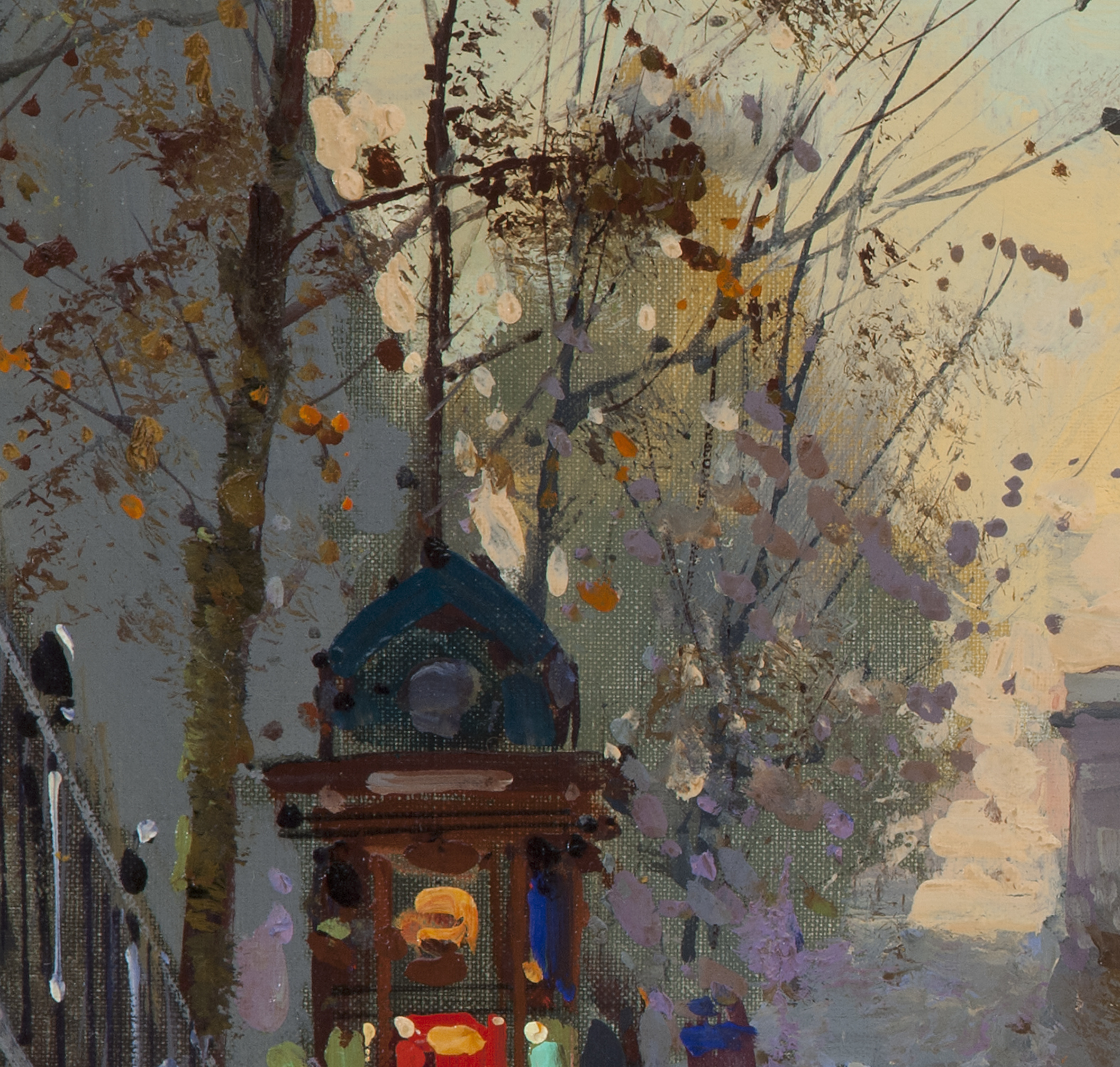
Areas in the painting left
"unfinished" by the artist
However, there are times when the ground or canvas is showing (bare spots), which was not done by the artist. In these cases, it is more than likely that the work has been 'skinned' or 'over-cleaned', leaving the areas abraded.
Before I go further, it is important to understand exactly what these terms mean and how this happens. When a competent conservator/restorer cleans a work of art, they use a variety of chemicals to remove the old finishing varnish (the uppermost layer of the painting that protects the paint surface). Before cleaning the entire work, they will test a few areas along the edge to see how the varnish and underlying pigments react to various chemical mixtures. After determining the proper mixtures, they will slowly remove the finishing varnish. Knowledgeable and talented conservators understand the different drying times of pigments and what chemicals are normally safe for works from different periods; once cleaned, only the finishing varnish and any previous in-painting will be removed.
But what about all those individuals who fancy themselves conservators but do not have the in-depth knowledge needed to clean works safely from different periods? A work in their hands can sustain damage. Remember that strong chemicals are used to clean a work of art, and using mixtures that are safe for a 150-year-old painting might have disastrous results on a work that is only 50 years old … and vice-versa.

Abrasion or over-cleaning
The terms 'skinning', 'skinned', 'over-cleaned', 'over-cleaning', and 'abraded' are used interchangeably to describe a condition where the original paint has been removed by someone other than the artist. This could be as minimal as removing a visually imperceptible amount of paint from the upper layers to actually removing enough paint to expose the ground or canvas. Skinning can also happen to works that have never been restored … I am sure you are wondering: How is that possible? During my career, I have seen several paintings where a housekeeper used dust rags (with furniture polish) to dust the front of a painting. Over time, these chemically soaked rags did 'clean' the painting … cleaning off areas of the original paint and skinning the work. It's not a pretty sight.
Once a painting has been skinned, there are only two options … one is to leave the areas as they are, letting the skinned areas show (see the images in this article), or paint over the damaged areas, thereby covering them up in an attempt to return the work to its original look. Either way, depending on the extent of the damage, the value of the work may have been altered.
People often ask about a work's condition, more specifically inquiring about the amount of in-painting. An honest individual will detail any condition issues that exist. But what we are seeing more and more of, especially with works being offered in the public forums, are paintings that have been skinned and not in-painted. You might ask - why? Well, if the damages are not in-painted, then the condition report will state that there is no in-painting. If there is no in-painting, then most people think that the work is in good condition … and this can be very deceptive because a work that displays extensive areas of over-cleaning is not in good condition.
We all know that having a little knowledge can be dangerous … and when trying to determine a work's condition, this saying is never more fitting. As a buyer, you must be conscious of all the subtle differences in the terminology used to describe a work's condition. Aside from those already mentioned, others include 'thinning' and 'thinned areas', also used to denote over-cleaning.
As with any condition problem, the extent of the 'over-cleaning' (damage) will determine how much value, if any, has been lost. A painting with some minor skinning in the background areas or a relatively unimportant part of the painting might still be classified as in fine condition, and there should be little change in the work's value. On the other hand, if the work's central focus, or large areas, has been skinned, then a detailed analysis of the damage needs to be made to determine how much value has been lost.
Ultimately, it is important to be aware that just because a condition report states that the work has little or no in-painting does not mean it is in good condition. There is more to it than what is written on a piece of paper … at times, it is what is not written!
The Rehs Family
© Rehs Galleries, Inc., New York – November 2024
